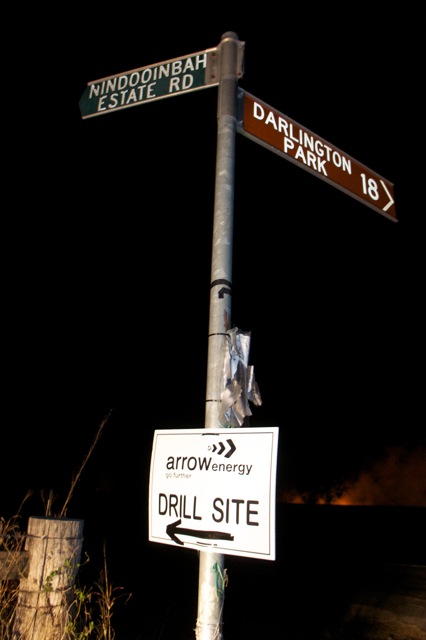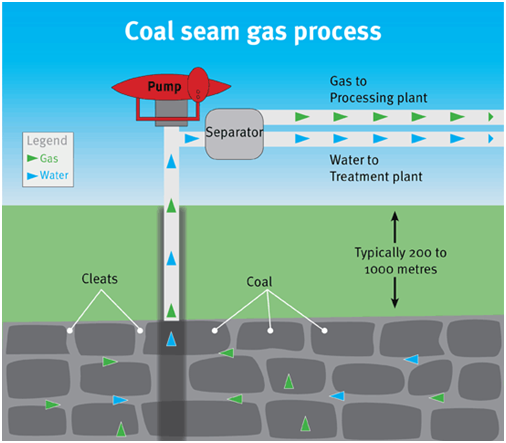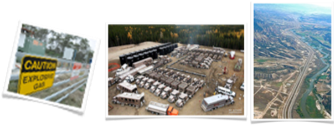 Latest News on gas company activity Arrow Energy, which controls all of the coal seam gas permits in the Scenic Rim, has publicly said it will be drilling in four locations in our region before the end of the year. We know of Nindooinbah Estate Rd at Kerry, Surawski Rd at Croftby and Tamrookum Creek Rd near Rathdowney - where we belive the drilling rig is currently operating. If you know of the forth place, please let us know. Some of these wells are reaching 'development' stage, which we are told is equivalent to a production well. As such Arrow is also approaching landholders near these wells as part of its next phase. If you are one of these people or you may have some more information, please let us know. Phone 5544 3233 or email keepthescenicrimscenic@gmail.com Coal Seam Gas - Fact Sheet
What is Coal Seam Gas? Often referred to as Unconventional Gas, Coal Seam Gas (CSG) or Coal Bed Methane (CBM) and not to be confused with Natural Gas, it is methane gas found in coal seams. The coal seam normally acts as a water aquifer and the methane gas is trapped in the coal by the water. Methane gas has no smell, it will asphyxiate and is highly explosive, which is why coal miners are fearful of it, as are landholders who find the bores or tap water supplies become flammable. Methane gas is a greenhouse gas more than 20 times worse than CO2. When burnt, methane produces 40% less greenhouse gas than coal, however the process of removing it from the coal seam sees a large amount of fugitive methane escaping into the atmosphere, so any perceived benefit is nullified. How is Methane Gas extracted from a Coal Seam? 
Coal seam gas is accessed via wells, drilled down into and, in some cases, along the coal seams. Large quantities of underground water are removed to release the gas. The process is sometimes sped-up using the controversial hydraulic fracturing (fracking) method: a slurry of sand, chemicals and water is injected underground at high pressure to shatter the coal seam and rock. Some of the chemicals used in the extraction are toxic and known to cause cancer. The Queensland and New South Wales Governments have banned the use of ‘BTEX’ chemicals – a combination of benzene, toluene, ethylbenzene and xylene – in fracking[18], but experts warn these compounds already exist in coal seams, potentially risking contamination of aquifers underground, surface water and soil.[4][15] ‘Doctors for the Environment Australia’ group says BTEX are often brought to the surface during gas extraction, as are other volatile organic compounds and radioactive substances. Traces of BTEX were detected in water samples at a CSG project in Queensland in October 2010, raising concerns of risk to water supplies and human health[16]. State Government investigations showed the incident arose during exploratory drilling for CSG. Livestock have also been contaminated at Kingaroy. These concerns and others have resulted in a total ban on fracking in France and a temporary ban in New South Wales, South Africa and parts of the USA.
Underground coal gasification: a risky gas extraction method also being investigated for our Scenic Rim Underground Coal Gasification (UCG) involves setting fire to previously inaccessible underground coal seams and harvesting the resulting produced gas. The controversial process has been used with mixed results in the Soviet Union and the Queensland government had allowed three trial sites close to Kingaroy. After a series of acknowledged issues – including chemical contamination of bore water and stock, and contamination of a creek resulting in numerous dead turtles - one of those trials has been shut down by the Government and two operators have been charged with contamination and failing to disclose contamination. One of the operators charged, Carbon Energy, is considering underground gasification in the Scenic Rim (EPC 1109 from south of Beaudesert to Lamington). Other Issues arising from coal seam gas extraction:
Waste water and aquifer cross-contamination: For a long time, Australia’s gas industry has denied it may be responsible for contamination, but this changed recently with a spokesperson for the Australian Petroleum Production and Exploration Association admitting aquifer contamination was inevitable. Ross Dunn said this week (Aug 2, 2011) that "good management could minimise the risks of water contamination, but never eliminate them". ''Drilling will, to varying degrees, impact on adjoining aquifers,'' said Mr Dunn, ''The extent of impact and whether the impact can be managed is the question.'' Gas production also results in significant quantities of toxic, highly saline, contaminated waste water, which must be transported from the well site by road tanker for treatment and disposal. Unlike farmers, Queensland mining companies do not need a water licence or face restrictions on the amount of water they can remove. Farmers and their representatives (including the National Farmers Federation and Agforce) have raised concerns about depletion of valuable underground reserves and mining company ‘make-good’ provisions when underground supplies fail. This includes drilling agricultural bores deeper or the last resort of trucking in supplies. From 2012, the Queensland government will require gas companies to ‘treat’ waste water for reuse. It is expected this will be done by reverse osmosis, although in the United States, there are known issues relating to chemicals in ‘frack water’ destroying filters and making this method unreliable. The Queensland Government has authorised the use of treated ‘waste water’ for town supplies, including drinking; aquaculture; recharging aquifers; wetlands; recreational lakes or at mining operations and power stations. Recent practice has been for poor quality water to be contained in storage ponds[12] . It is expected some of these will remain for the short term, despite proven examples of contamination of land, surface water and livestock.

Noise and infrastructure – Coal seam gas production is not just a little hole in the ground: full scale gas extraction involves extensive infrastructure, threatening home-life and agricultural practices: In Queensland, gas wells can be drilled 100m from residential housing, 400-1000m apart, with access roads and possibly pipelines and new power lines crossing your land. Where grid supplies are unavailable, large generators are used to power pumps. Gas and waste water is most often removed by trucks (see picture above – a typical Icon Energy ‘frac set-up’). These trucks must travel through our communities to their designated pipeline feed-point or water treatment plant as dramatically highlighted by this US documentary excerpt. 24-hour compressor stations are used at regular intervals to move gas along the pipelines and to separate unwanted hydrocarbons from the gas. These are vented into the atmosphere, despite being known to cause cancer. An online search of existing Queenland gas operations at Tara and on the Darling Downs shows many residents struggle to live with the low-grade noise from 24/hour compressor stations, even if they are several kilometres away.
To understand more about living with gas wells and their associated infrastructure, please read these real-life accounts from Darling Downs residents: Katie Lloyd recently described how gas wells have impacted on her family life and cattle feedlot business – including living with ‘strangers’ who now work on their land and use their driveway for access to wells, passing close to her house. All privacy is lost and she no longer feels it is safe for her children to play outside or ride their bikes in their backyard unsupervised. Read about the Lloyd Family’s experience >> Anne Bridle’s submission to the recent Senate Inquiry into coal seam gas describes in detail the problems she and her husband face, juggling gas company rights with the operation of their large scale Santa Gertrudis cattle stud, south of Dalby. The family is facing numerous challenges including contamination of their aquifer water supply – admitted by the gas company (PDF 820KB)
Your health and safety - There are many hazards involved with CSG extraction. The water taken from the coal seam is toxic and must be handled with extreme care. Doctors for the Environment Australia has warned of potential long-term coal seam gas related hazards including cancer and deformities in its submission to the coal seam gas senate inquiry. After the water has been removed from the coal seam, the dynamics of the coal seam have been changed causing the methane to be freed up and migrate: the hope is that all the methane will find its way up to the well head, however rocks can and do have fault lines by which the methane can find alternate avenues to the surface. There are many instances of methane coming out of people’s taps. CSG wells and pipelines are fire hazards; over 50% of wells tested in Queensland’s Tara Estate leak methane. CSG wells do sometimes catch fire and explode. Once the methane has been freed up from the coal, nothing will stop it flowing.
Is your property under exploration
licence? Go to the State Government's website or look on our maps http://www.dme.qld.gov.au/mines/tenure_maps.cfm
|
How will coal seam gas affect my rights?
In a number of ways. You will discover that your legal rights are very limited: you do NOT have the right to say no to drilling or mining on your land. You do have the right to compensation. However in practice, many land-holders are choosing to ‘Lock The Gate” and refuse to negotiate with mining companies. To date, no landholder has been taken to court by a mining company wanting access. Strength in the numbers of farmers uniting to say no means court action is unlikely and would be supported as a test case should it occur. Mining companies have publically said they are not interested in challenging landholders in court, preferring to avoid bad publicity and if possibly negotiate access.
Keep the Scenic Rim Scenic recommends you do not begin negotiations with any resource company until you are familiar with your rights, have legal support and have discussed the issue with your neighbours. If you allow a mining company access to your property then you are opening your door to a sequence of events that you could regret for the rest of your life. Make sure you and your neighbours act with one voice. The industry will charm you and try to minimise their activities - a typical line of theirs is "we have no plan to ..." just remember that plans always change. If they approach you make sure you record every moment, preferably with a video camera and try to have a witness. When a mining company representative first approaches your home, you can adopt a ‘locked gate’ principle - if you ask them to please leave, they must go. The situation changes once they are in production because they then have a legal right to enter your property with or without your permission. Keep the Scenic Rim Scenic is planning to invite a specialist gas lawyer to its next major information session to expand on this information.
Potential Impacts from CSG development to consider: * The value of your property may be altered * The equity you hold in your business may be altered * Your ability and capacity to generate income from your land and resources may be altered * Your ability to meet market or other compliance schemes may be compromised (Examples: Biosecurity, WPHS, Organic Certification, Quality Assurance Schemes) * Your ability to adopt new technologies/farming practices in the future may be altered * Your ability to carry out normal activities on your land may be compromised * You will spend a significant amount of time (otherwise used for your business) to understand CSG development and negotiate with the CSG company * You may become overwhelmed by the enormity of the decisions before you and the timeframes under which you are expected to respond * You may have concerns about the long‐term environmental impact on your land and water resources and their implications for you and your family/staff/ community’s health, stock health and food safety * You will have to consider that any payments for compensation for impact are structured correctly to avoid excessive taxation * You may experience a loss of privacy with CSG employees and contractors accessing your land. * The exclusive rights you previously enjoyed to your land may be forever changed. * There will be flow on affects due to the impact on your land and business to the community, business and social environments in which you operate. This is not an exhaustive list…but is presented to demonstrate the complexities of the considerations you may need to take and to highlight the need to seek expert advice on many matters. You may also wish to refer to the government booklet “Tips for landholders negotiating agreements with resource companies”. The Government’s landholder information can be found at: http://www.dme.qld.gov.au/mines/land_owner_occupier_information.cfm
WHAT CAN YOU DO AS A LANDHOLDER TO HELP YOURSELF? * Check to see which CSG company/s has tenure over your property. See Government website: http://www.dme.qld.gov.au/mines/tenure_maps.cfm * Educate yourself about the CSG company which has tenure over your land. * Calculate the “Worst‐ Case” CSG Well Impact Scenario for your land given the CSG Company’s conceptual gasfield development plans. This CSG Well Calculator has been created by the Basin Sustainability Alliance. Go to the calculator >> * Understand that YOU HAVE RIGHTS over your land ‐ It simply may not be possible for the CSG company to roll out its conceptual gas field development plans across your property if it intends to avoid unreasonably interfering with your business – although you may have to fight for your rights. * Engage your solicitor in all your communications and negotiations with the CSG Company from the outset. * Take stock of your business and consider your future development plans for your land and the multifunctionality value your land offers without CSG development. * If you have a water licence, entitling you to take groundwater, you will need to be proactive in protecting your long‐term water supply. Check your licence details particularly to see from which aquifer you are licensed to take water from, check the proximity of your water supply aquifer to the Coal Measures and take this information along with your water bore logs to your solicitor. * Gather baseline information with independent advice and using recognised baseline guidelines: water, air, noise, visual, etc. * Seek independent professional advice on Land Valuations, Agronomy, Hydrology and Engineering to help you develop your negotiating position with the CSG Company. These professionals can advise on recent changes in land valuation and the impact of CSG operations on land values, impacts of CSG operations on the productivity of your farming or grazing operation, vulnerability of your current water bores and likely impact of CSG infrastructure on your operations. * Understand that CSG development on your land is business – and serious business at that – get everything in writing and always respond in writing so that you establish a paper trail of correspondence between yourself and the company representative/s. * Talk to your neighbours and nearby landholders, as the CSG footprint each of you consider or potentially sign off on could affect each of you. * You cannot rely on the CSG Company to fully disclose all their plans for your land to you and this will make it difficult for you to consider the full impact on your land and business. You need to do your own research and study fully any environmental management plans and/or environmental authorities that impact you. * If possible, KTSRS recommends meeting your CSG Landholder Liaison Officer on neutral territory such as your solicitor’s office rather than meeting across the kitchen table in your family home. * Under the new land access legislation, resources companies are now required to pay for a landholders’ reasonable legal and accounting advice when negotiating a land access, compensation or deferral agreement. Keep the Scenic Rim Scenic is here to support our community. If you are concerned or need advice please do not hesitate to contact us. We will be able to provide contacts for experts and we can also put you in touch with other landholders who have personal experience of the gas industry.
We are most grateful to the Basin Sustainability Alliance http://www.basinsustainabilityalliance.org/index.html for their assistance in preparing the above material. Communities working together are a powerful force.
Disclaimer: This document is a work‐in‐progress Fact Sheet aimed to assist KTSRS members and landholders generally to understand the critical importance of the decisions they face when considering CSG development over their land. It is general in nature and not intended as legal or other advice.
|
